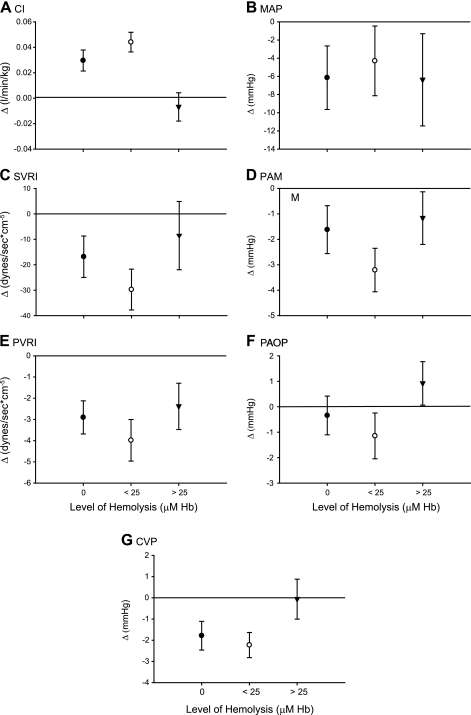Fig. 3.
Cardiovascular effects of nitrite during intravascular hemolysis. The cardiovascular effects of nitrite (27.5 mg/h) at different levels of cell-free plasma hemoglobin (Hb; 0, < 25 μM, and >25 μM) are shown in A–G. For each parameter, the isolated effect of nitrite is displayed after controlling for animal variability and the independent effects of hemolysis. The depicted value represents the mean change in the parameter from time 0 to 1.5, 3, 4.5, and 6 h for all animals within the specified hemolysis group (x-axis: 0 μM, •; <25 μM, ○; and >25 μM, ▾). According to previous experiments, if nitrite functioned purely as a nitric oxide (NO) donor, then there should be progressive attenuation of the vasodilatory effects of nitrite with increasing levels of hemolysis; the NO generated from nitrite should be progressively scavenged by the increasing levels of cell-free plasma Hb (52). In these experiments, the effect of nitrite was dependent on the level of intravascular hemolysis (P = 0.01 for a differing effect of nitrite at low-level hemolysis compared with zero and high-level hemolysis across the 7 physiologic variables combined). A consistent U-shaped relationship between the physiological effects of nitrite and the levels of cell-free plasma Hb was detected. At low levels of hemolysis (Hb concentration < 25 μM), the vasodilatory effects of nitrite were potentiated, whereas with higher levels of hemolysis (cell-free plasma Hb > 25 μM), the expected inhibition of the vasodilatory effects of nitrite were observed.

